Training Reports 2010 - Langelands Museum, Denmark

Four Early Stage Researchers took part in survey and excavation of the submerged landscape of Helnaes Bay off the coast of the island of Funen in Denmark during June 2010. The operation was led by Otto Uldum of the Langelands Museum.
Individual STSM reports are summarised below.
Kieran Westerly (Research Associate, University of Ulster, Northern Ireland)
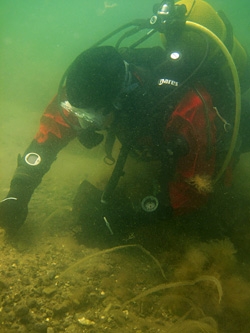
In June 2010, I took part in an STSM in Denmark along with other SPLASHCOS members. The project consisted of a five-day dive reconnaissance survey of Helnaes Bay, situated on the southwest coast of Funen Island and was run by the Langelands Museum. The main aim of the survey was to locate submerged prehistoric archaeological material. Small zones within Helnaes Bay had previously been surveyed, and some lithic material had been identified. However, the vast majority of the Bay remained unsurveyed.
The surveys we took part in were done using conventional scuba kit in shallow (<4m) water and relied on visual inspection of the seabed and digging small test pits by hand-fanning. Over the course of the survey, we made numerous dives and found a range of archaeological and palaeoenvironmental evidence. This included lithic material, exposed and buried peat beds and the remains of tree root systems. For the first four days, we found mainly reworked and water-rolled lithics. However, the real highlight came on the penultimate day when a deposit of in situ lithics was found. These were still sharp, unpatinated and formed a dense concentration.
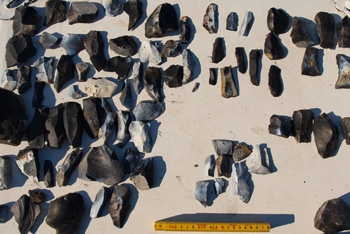
Systematic test-pitting on the final day suggested that the deposit covered an area of at least 30m².
Overall, the STSM was a great experience and an invaluable training exercise. It was extremely useful to be able to participate in aspects of underwater prehistoric survey ranging from choosing a survey area to carrying out underwater test-pitting work. Added benefits included greater experience in identifying archaeological and palaeo-environmental evidence underwater and sampling techniques for such material.
Many thanks are due to Otto Uldum for organizing the survey and, along with the rest of the Mjølnir team – Hans, Flemming and Arne – for making it such a useful and rewarding experience.
Ehud Galili (Senior Research Fellow, Israel Antiquities Authority and University of Haifa)
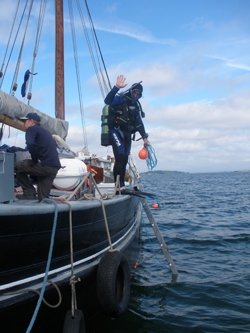
The purpose of the STSM survey was training in using a Danish Model for underwater survey to discover submerged prehistoric material and relevant paleoenvironmental data. The specific aim was to locate prehistoric sites in the Helnaes Bay area of western Funen, Denmark.
The main portion of the training was carried out during five days of a diving survey. The project was led by Otto Uldum from the Langelands Museum and involved the use of the Danish Vessel Mjølnir, and the two smaller support vessels. We used navigational GPS and nautical bathymetric maps to locate submerged features, and conducted diving in 1–3m depth of water, and underwater cleaning of the seabed and test excavation. We diagrammed, photographed and reported all findings, and bagged and documented lithic material collected on each dive. A previously known megalithic structure was documented and measured by the team.
Numerous pieces of flint were found on the seabed during most dives, but many of these were not artefacts but the result of natural processes such as glacial activity. We also took samples from a 3 m long linear feature of wooden material embedded in the clay sediments on the seabed, to determine whether this was man-made, or a submerged tree root, and re-located and measured a previously reported underwater megalithic structure.
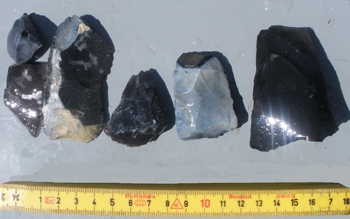
The main find was an extensive cultural deposit (at least 35m x35m) 1km south of Felsled Bay Harbour, with a significant concentration of worked lithics, including flakes, finely worked blades, cores, core preparation elements, tools an adze, a flake axe and some bones. This new site offers future opportunities for excavations and studies of submerged landscapes and settlements in Danish waters. On land opposite this underwater location, many worked artefacts were observed. This suggests that coastal surveys on land may help in locating submerged sites.
Future work at the site and in the region is planned. As an excavator of submerged Neolithic sites in Israel I was glad to have the opportunity of participating in this interesting project and will be glad to participate in future activities in Danish waters.
Jonathan Benjamin (Postdoctoral Fellow, School of History, Classics & Archaeology, University of Edinburgh)
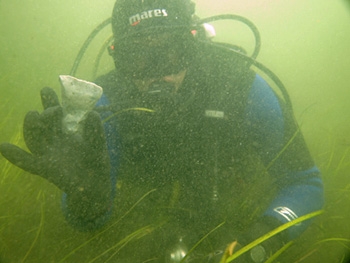
The purpose of the STSM was training in the Danish Model for underwater survey, and the techniques of locating and studying submerged prehistoric archaeological and palaeoenvironmental material, with particular focus on locating sites in the Helnaes Bay area of western Funen, Denmark. Additional goals of this STSM were to visit the regional institutions and museums that are involved in underwater archaeology, prehistory and heritage management.
The main portion of the training was carried out during five days of diving survey, led by Otto Uldum with the involvement of three other local divers experienced in this sort of activity. The platform was the Danish Vessel Mjølnir, owned by the Langelands Museum. Two additional boats were used to provide access to diving sites, a fibreglass dingy and a small motorised inflatable. There was a dedicated dive officer keeping a record of all dives in and out of the water, their times, and locations. Divers maintained contact with the boats by diving in pairs and with surface marker buoys. Dives were generally between 1–3m, which can be considered quite shallow. Divers surveyed for indications of submerged prehistoric material on the seabed (i.e. worked lithics) including cleaning of the seabed and test excavation, drawing, photographing, and reporting all findings to the STSM leader, and collection and bagging of lithics following each dive.
The main results were the discovery of numerous worked flint pieces on the seabed found during the majority of dives, a linear wooden feature embedded in the seabed, later determined to be natural, and a large concentration of worked flint 1km south of Felsled Bay Harbour on day four of the survey. The wooden feature represents tree roots, possibly from a tree that was drowning, and is thus a potentially very interesting paleoenvironmental find. Samples were taken during a test excavation conducted by Otto Uldum and Ehud Galili.
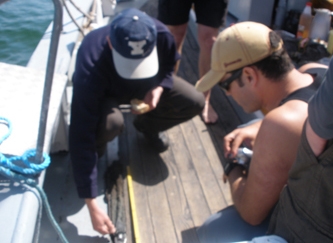
The concentration of flint is a very significant find of worked lithics, and three bones were also recovered during this initial day of discovery. A second day of diving on this site was conducted in order to measure out the extent of the area. Test pits along perpendicular 30m lines provided evidence that the site is significant, and at minimum 30m x 30m, and almost certainly larger. Artefacts discovered included finely worked blades, an adze and a flake axe, all from flint. This represents a significant new site in Danish waters.
I am hopeful that this very successful survey will lead to future work with the Langelands museum, possibly in the form of another STSM next year with an emphasis on excavation. This site offers a wonderful resource for young researchers to initiate a test excavation on a potentially important submerged Mesolithic site.
As part of a forum piece that I have published in the Journal of Island and Coastal Archaeology, I have ended my forum commentary by referencing this STSM and the SPLASHCOS project (giving the website as an online resource). I am also hopeful that future work will lead to a new site and the many potential publications that should come from such archaeological fieldwork.
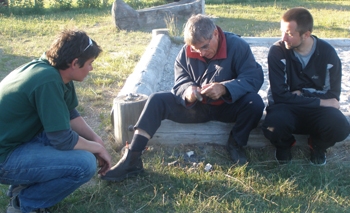
After the week of diving, along with Ehud Galili (Israel) and Kieran Westley (UK), I visited the Viking ship museum in Roskilde, which is an important research institute for underwater archaeology of all periods in the region. I also went to Kalundborg where I met with Anders Fischer of the National Heritage Agency to discuss diving in Denmark, heritage management strategies, and the publication of the volume on submerged prehistory.
I found it particularly helpful that in addition to a few early stage researchers, we had the presence of not only the STSM leader, but also an experienced researcher and field practitioner from another geographical location (in this case Ehud Galili). This was very useful, since his presence allowed for us to listen and learn not only from the Danish experts, but also to observe an experienced practitioner in a new environment (along with us) for the first time. I think this made for a very strong learning / training experience and would strongly encourage future STSMs to include one experienced researcher who is not from the STSM host region.
Freder Feulner (Post-doctoral Research Associate, Department of Archaeology, University of York, UK)
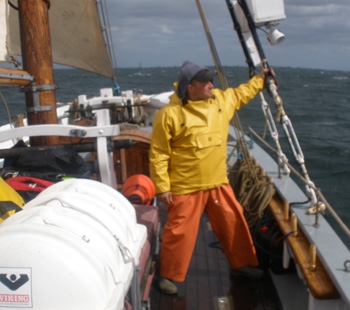
My Short-Term Scientific Mission (STSM) of the SPLASHCOS action took place in Denmark from July 14th to 18th 2010. The host institute was the Langelands Museet, a regional museum on the island of Langeland, which is based in the harbour town of Rudkøbing.
It offered the chance to directly exchange knowledge, discuss finds and the change of the landscape in this area. The first days of diving were not very exciting, but showed the necessary survey work which has to be done in advance in order to locate new places, failures included. But the last part, the discovery of a possible full scale settlement site near Falsled proved the whole diving trip worthwhile. Finding a place like this almost on the surface could mean that many other similar sites have been eroded and washed away by currents and waves. The nearby deeper muddy layers need further investigation as there might be a good chance of recovering preserved organic finds.
- Read more and see more photos (PDF file)








